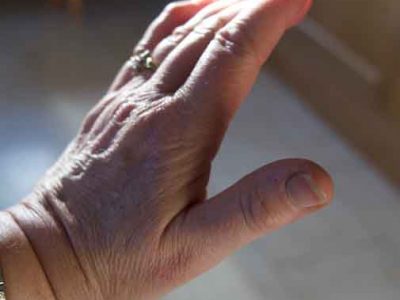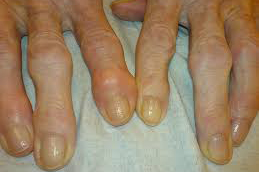Arthritis involves inflammation of one or more of your joints. Pain and stiffness are common symptoms of arthritis, and when these occur in your wrist, simple daily activities can become more difficult.
There are many types of arthritis and most of these can affect the wrist. Although the severity of symptoms related to arthritis can vary, most arthritis-related diseases are chronic.
Anatomy of the wrist
The wrist is a complex joint made up of multiple small joints It is formed by the two bones of the forearm—the radius and the ulna—and eight small carpal bones. The carpal bones are arranged in two rows at the base of the hand. There are four bones in each row. These bones are designed to glide easily over each other during movement, protected by smooth cartilage that coats the joint surfaces. The arthritis damages the articular cartilage which means that the bones rub against each other causing pain and joint damage that cannot be repaired.
There is no cure for arthritis but there are many treatment options available to help relieve the symptoms. Some options may also slow the progression of joint damage. With proper treatment, many people are able to manage their symptoms and stay active.
Types of Arthritis
Although there are many types of arthritis, the three that most commonly affect the wrist are:
1. Osteoarthritis
Osteoarthritis can develop due to normal “wear-and-tear” in the wrist, particularly in people who have a family history of arthritis and generally occurs in older age. In osteoarthritis, the smooth, slippery articular cartilage that covers the ends of the bones gradually wears away over time. Because the cartilage surface has little to no blood supply, it has little ability to heal or regenerate when it becomes injured or worn down. As the cartilage wears away, it becomes frayed and rough, and the protective space between the bones decreases. This can result in bone rubbing on bone and lead to pain and stiffness in the joint.
2. Rheumatoid arthritis
Rheumatoid arthritis is a chronic disease that can affect multiple joints throughout the body. The condition often starts in smaller joints, such as those found in the hand and wrist. It is symmetrical, meaning that it usually affects the same joint on both sides of the body.
3. Posttraumatic arthritis
Posttraumatic arthritis can develop after an injury, such as a broken wrist bone or a torn ligament. This trauma can cause a direct injury to the cartilage or a delayed wearing of the cartilage due to a change in the way the bones move together—such as after a ligament tear.
Posttraumatic arthritis can develop over many years from the initial injury. Despite proper treatment, an injured joint is more likely to become arthritic over time.


Symptoms of Arthritis of the wrist and hand-
1. Pain
2. Swelling
3. Reduced range of motion of the wrist
4. Weakness
5. Thickening of the bone and nodules on the fingers
Treatment
There is no cure for arthritis, but there are a number of treatments that may help reduce the frequency of your symptoms and relieve the pain and loss of function it can cause.
Nonsurgical Treatment
In general, initial treatment for arthritis is nonsurgical in nature and designed to help minimize your symptoms.
Nonsurgical treatment options may include:
- Activity modification. Limiting or stopping the activities that make your pain worse is the first step in relieving symptoms.
- Wearing a wrist splint for a short time will help support the joint and ease the stress placed on it by frequent use and activities.
- Nonsteroidal anti-inflammatory drugs (NSAIDs) such as aspirin, naproxen, and ibuprofen can help reduce both pain and swelling. Topical NSAIDs can be applied directly to the skin in the area of the joint.
- Specific exercises will help improve range of motion and function in your wrist and hand. Your doctor or a physiotherapist can help develop an exercise program that meets your specific needs.
- Steroid injection. Cortisone is a powerful anti-inflammatory agent that can be injected into an arthritic joint. Although an injection of cortisone can provide relief and reduce inflammation, the effects may be temporary.
- Other therapies. This may include using “contrast soaks” of warm and cold water to help reduce swelling.
Surgical options
If nonsurgical treatment does not relieve your pain and your quality of life has been significantly affected by arthritis, your doctor may recommend surgery.
The goal of surgery is to relieve pain while preserving or improving hand function. Typically, this is done by minimizing or eliminating bone-on-bone contact. There are a number of procedures for arthritis of the wrist. Your doctor will talk with you about which procedure will work best in your case.
Proximal row carpectomy. In this procedure, your doctor removes three carpal bones in the row of bones that is closest to the forearm. The procedure is designed to reduce your pain while maintaining some wrist motion.
Fusion. If motion is the source of your pain, your doctor may recommend fusion. Fusion is essentially a “welding” process. The basic idea is to fuse together the bones so that they heal into a single, solid bone. The theory behind fusion is that, if the painful bones do not move, they should not hurt.
During the procedure, your doctor removes the damaged cartilage and then uses pins, plates, or screws to hold the joint in a permanent position. Over time, the bones fuse or grow together— similar to the way the fractured ends of a bone heal together.
In some cases, your doctor can perform a partial fusion in which just some of the carpal bones are fused together. This addresses the damaged joint surfaces, but leaves the healthy joints intact to preserve some wrist motion.
If your arthritis is extensive, however, a complete wrist fusion may be necessary. In this procedure, all of the carpal bones are fused together, along with the radius (one of the bones in the forearm). Although all wrist motion is eliminated in a complete fusion, forearm rotation and finger/thumb motion are generally preserved.
Source- Orthoinfo.aaos.org

